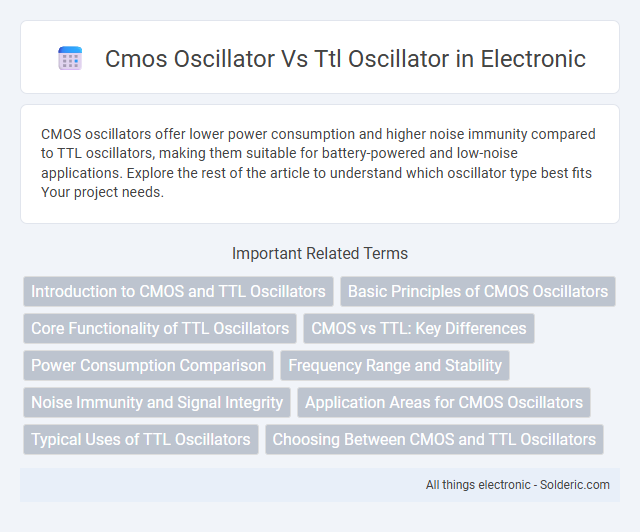CMOS oscillators offer lower power consumption and higher noise immunity compared to TTL oscillators, making them suitable for battery-powered and low-noise applications. Explore the rest of the article to understand which oscillator type best fits Your project needs.
Comparison Table
| Feature | CMOS Oscillator | TTL Oscillator |
|---|---|---|
| Technology | Complementary Metal-Oxide-Semiconductor (CMOS) | Transistor-Transistor Logic (TTL) |
| Power Consumption | Low power consumption | Higher power consumption |
| Operating Voltage | Typically 3V to 15V | Typically 4.75V to 5.25V |
| Frequency Range | Wide frequency range, from kHz to MHz | Moderate frequency range, mainly MHz range |
| Output Waveform | Square wave with slower edges | Square wave with fast edges |
| Noise Immunity | High noise immunity | Lower noise immunity |
| Cost | Generally lower cost | Relatively higher cost |
| Applications | Battery-powered and low-power devices | High-speed digital circuits |
Introduction to CMOS and TTL Oscillators
CMOS oscillators utilize complementary metal-oxide-semiconductor technology, known for low power consumption and high noise immunity, making them ideal for battery-powered and precision applications. TTL oscillators, based on transistor-transistor logic, offer faster switching speeds but consume more power and generate more heat, suitable for high-speed digital circuits. The choice between CMOS and TTL oscillators depends on application requirements like power efficiency, speed, and signal integrity.
Basic Principles of CMOS Oscillators
CMOS oscillators operate by exploiting the high input impedance and low power consumption of CMOS transistors, which switch between stable states to generate periodic waveforms. Unlike TTL oscillators that rely on bipolar junction transistors, CMOS designs use complementary MOSFET pairs to achieve oscillation with minimal power dissipation and greater noise immunity. Your choice of a CMOS oscillator benefits from its superior efficiency and compatibility with low-voltage digital circuits, making it ideal for battery-powered and portable applications.
Core Functionality of TTL Oscillators
TTL oscillators operate by rapidly switching transistor-transistor logic gates between high and low states, generating stable square wave signals ideal for digital circuits. Their core functionality emphasizes fast transition times and noise immunity, making them suitable for timing applications requiring reliable pulse generation. Compared to CMOS oscillators, TTL oscillators typically consume more power but offer superior speed and robustness in noisy environments.
CMOS vs TTL: Key Differences
CMOS oscillators feature low power consumption and high noise immunity, making them ideal for battery-powered and high-precision applications. TTL oscillators, based on bipolar junction transistors, offer faster switching speeds but consume more power and generate higher heat compared to CMOS. Understanding these key differences can help you select the best oscillator type to optimize circuit performance and energy efficiency.
Power Consumption Comparison
CMOS oscillators typically consume significantly less power compared to TTL oscillators due to their high input impedance and low static current leakage. TTL oscillators draw more current as they rely on bipolar junction transistors, which produce continuous base current even when idle. When optimizing your circuit for energy efficiency, choosing a CMOS oscillator can reduce overall power consumption and improve battery life.
Frequency Range and Stability
CMOS oscillators offer a wider frequency range, typically from a few Hertz up to several megahertz, while TTL oscillators generally operate within a narrower band, often limited to lower frequencies around a few megahertz. CMOS technology provides superior frequency stability due to lower power consumption and reduced temperature sensitivity, making it ideal for precision timing applications. Your choice between CMOS and TTL oscillators should consider the required frequency range and stability to ensure optimal performance in your electronic circuits.
Noise Immunity and Signal Integrity
CMOS oscillators exhibit superior noise immunity compared to TTL oscillators due to their high input impedance and lower power consumption, which reduces susceptibility to electrical interference and signal distortion. TTL oscillators generate stronger signals with faster rise times but are more prone to noise coupling and signal degradation in electrically noisy environments. Selecting CMOS oscillators enhances signal integrity in sensitive applications, while TTL oscillators may be preferred for high-speed switching where noise immunity is less critical.
Application Areas for CMOS Oscillators
CMOS oscillators excel in low-power applications such as battery-operated devices, portable instruments, and embedded systems due to their high input impedance and low static power consumption. They are widely used in timing and clock generation circuits for microcontrollers, digital watches, and RF communication modules where energy efficiency and stability are critical. CMOS technology also supports integration in complex ICs, making these oscillators ideal for modern consumer electronics and sensor networks requiring precise frequency control.
Typical Uses of TTL Oscillators
TTL oscillators are commonly used in digital circuits requiring fast switching speeds and compatibility with standard TTL logic levels, such as clock generation in microprocessors, timing applications, and frequency synthesis. Their ability to operate at higher frequencies with low propagation delay makes them ideal for synchronous system timing and pulse generation. You will often find TTL oscillators integrated into communication devices, digital signal processing, and control systems where precise timing is critical.
Choosing Between CMOS and TTL Oscillators
Choosing between CMOS and TTL oscillators depends on power consumption, speed, and noise immunity requirements. CMOS oscillators typically offer lower power consumption and higher noise immunity, making them ideal for battery-powered and low-noise applications. TTL oscillators provide faster switching speeds and are preferred in high-frequency or legacy TTL-based circuits.
cmos oscillator vs ttl oscillator Infographic

 solderic.com
solderic.com